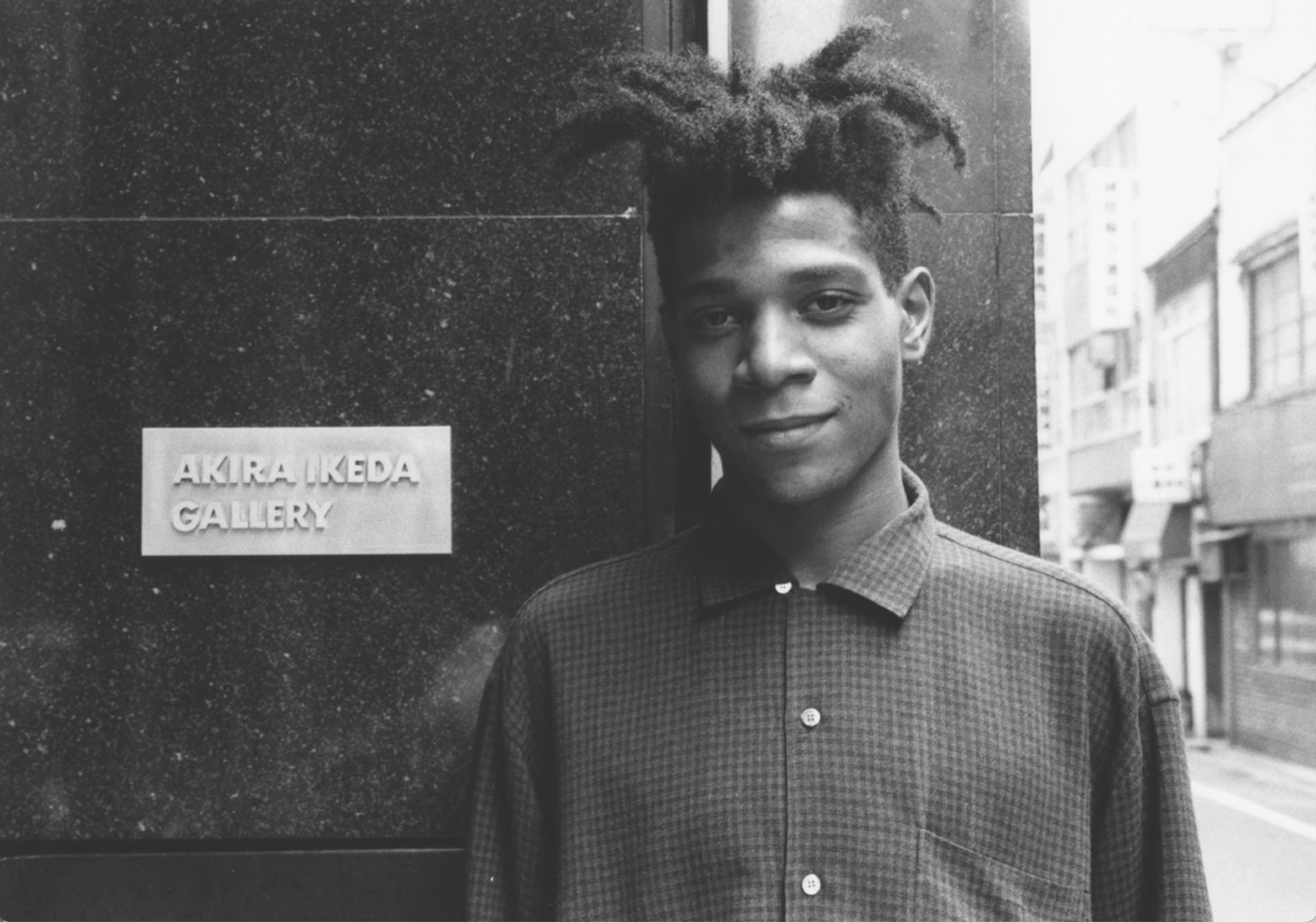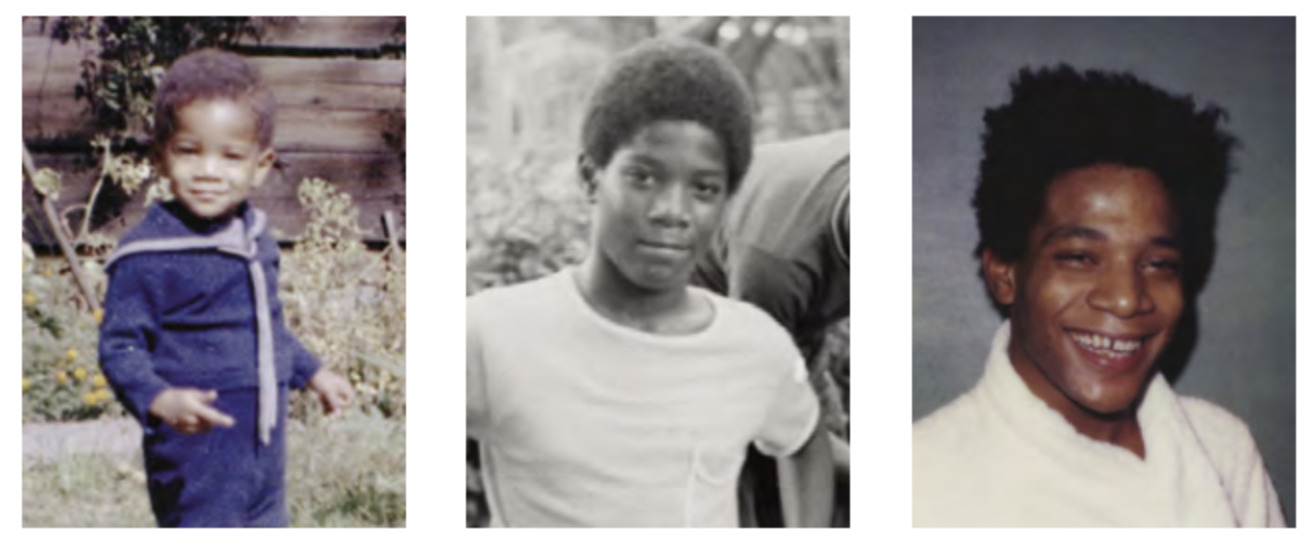Overview
Who is Jean-Michel Basquiat?
Born and raised in Brooklyn, New York, Jean-Michel Basquiat was the son of a Haitian-born father and a Brooklyn-born mother of Puerto Rican descent.
As a child, he loved to draw and look at art. He grew up to become one of the world’s most famous artists.

Grade Level
6-12
Media Theme/Big Idea
Jean-Michel Basquiat often returned to the same motifs in his work, repeating them multiple times in the same painting to create a visual rhythm.
Essential Questions
Looking closely, making connections, and responding to selected works of art featured in the exhibition Jean-Michel Basquiat: King Pleasure.
Materials and Tools
- Paper
- A drawing tool such as a pencil, pen, colored pencil, or marker
Activities
Step 1: In the first gallery, find:
A self-portrait is a painting of the artist, made by the artist.
- Look closely at this self-portrait by Jean-Michel Basquiat.
- Now look at this photo of Jean-Michel Basquiat. How are the photo and the painting similar? How are they different?

Look around this gallery. What clues can you find about Jean-Michel Basquiat?
Draw or write three things you find.
Step 2: In the next gallery, find:
These drawings show some of Jean-Michel Basquiat’s favorite things when he was a child.

Jean-Michel Basquiat loved watching cartoons, and he liked to draw with the TV on to get ideas.
- What do you notice about the different characters in this drawing? What story do you imagine is happening?
- This drawing is of one of Basquiat’s favorite childhood cartoons, Gumby. Who is your favorite cartoon character?

This is a drawing of a person and their cart.
- Look closely at the cart.
- What do you notice about it?
- What do you notice about the person?
This person is selling piraguas from their cart on the street. A piragua is shaved ice, shaped like a cone and covered with fruit-flavored syrup. You can find piraguas in Puerto Rico,
where Jean-Michel Basquiat lived for two years as a teenager, and in NYC where he grew up.
- Jean-Michel Basquiat loved to eat piraguas on hot summer days. What is your favorite summer treat?
Step 3: In the next gallery, find:

Jean-Michel Basquiat’s mother loved to take him to museums where they looked at art together. Basquiat said, “…my mother gave me all the primary things. The art came from her.”

Walk through the room that looks just like Jean-Michel’s childhood home.
Step 4: In the next gallery, find:

- What’s the first thing you notice about this painting?
Jean-Michel Basquiat started this artwork by drawing on paper, photocopying his drawings, and creating a collage of the pieces by arranging and gluing them onto the canvas. Then he painted and drew on top of the collage with oil sticks and acrylic paint.
- What drawings do you see repeated?
- What do you notice about this head? How would you describe the colors and lines that he used to create it?
- Notice where he covered the collage with paint. Where do you see the collage peeking through the paint?
Step 5: Jean-Michel Basquiat’s Favorite Things
As you walk through the rest of the exhibition, look for things that Basquiat included in his artwork over and over. When you find them, draw what you see on the back of this page.

Writing
Jean-Michel Basquiat loved to read, and he liked to play with words. He purposely used incorrect spellings and crossed-out and repeated words and phrases. He said, “I cross out
words so you will see them more; the fact that they are obscured makes you want to read them more.”

Crowns
For Jean-Michel Basquiat, crowns represented many things, such as power, strength, and respect.
According to his sister Jeanine, he used crowns in his paintings to honor the kings and queens that made up his personal world history, including Black musicians and athletes.

The Human Body
When Jean-Michel Basquiat was 7-years old, he was in an accident. While he was recovering, his mother gave him a copy of Gray’s Anatomy, a medical textbook with images of the human body. Gray’s Anatomy inspired Basquiat’s drawings of people, which often show both the inside and
outside of bodies.

Cars, Trucks, and Airplanes
As a child, Jean-Michel Basquiat traveled to Puerto Rico, where his family was from. When he grew up, he traveled all over the world. Some of his favorite places were Abidjan,
the capital of Côte d’Ivoire in Africa, and Maui in Hawaii.

Music
What do you hear? You are listening to one of Jean-Michel Basquiat’s favorite songs.
Music was very important to him. He loved many different styles of music, from the jazz records his father played in his childhood home, to hip-hop, reggae, rock, ska, punk, and disco. Jean-Michel Basquiat listened to music while he painted and often included images of musicians, instruments, and song lyrics in his work.
Vocabulary
Motif: a recurring image, theme, or pattern that appears in
a work of art.
Silkscreen: a printing technique where a mesh is used
to transfer ink onto a surface, except in areas made
impermeable to the ink by a blocking stencil. A blade or
squeegee is moved across the screen to fill the open mesh
spaces with ink. One color is printed at a time, so several
screens can be used to produce a multi-colored image.
Visual Rhythm: a principle of design that suggests movement or action. Rhythm is usually achieved through repetition of lines, shapes, and colors. It creates a visual tempo in artworks and provides a path for the viewer’s eye to follow.
Resources
Jean-Michel Basquiat: King Pleasure
Exhibition website: kingpleasure.basquiat.com
Basquiat (2005). Brooklyn Museum of Art
brooklynmuseum.org/opencollection/exhibitions/614
Web page from the Brooklyn Museum’s Basquiat retrospective in 2005; includes an in-depth analysis of Basquiat’s work and life
Basquiat: The Unknown Notebooks. Brooklyn Museum of Art
Teacher resource from the exhibition, Basquiat: The Unknown Notebooks, at the Brooklyn Museum brooklynmuseum.org/search
Spotify© playlists inspired by Basquiat: King Pleasure
Listen Like Basquiat: Childhood
Listen Like Basquiat: Studio
Listen Like Basquiat: Nightlife
Listen Like Basquiat: Legacy
Books
Radiant Child: The Story of Young Artist Jean-Michel Basquiat, Javaka Steptoe. New York: Little, Brown Books for Young Readers, 2016.
Life Doesn’t Frighten Me, Maya Angelou
Poems by Maya Angelou, paintings by Jean-Michel Basquiat.
Edited by Sara Jane Boyers. New York: Stewart, Tabori & Chang, 1993.
Jean-Michel Basquiat, Essays by Dick Hebdige, Klaus Kertess, Rene Ricard, Greg Tate, and Robert Farris Tompson. Biographical Chronology by Franklin Sirmans.
New York: Whitney Museum of American Art, 1992.
Films
Basquiat: Rage To Riches – BBC Studios
bbcstudios.com/case-studies/basquiat-rage-to-riches
Basquiat: Rage To Riches is a BBC Studios Documentary
Unit production for BBC Two and PBS in association with
Thirteen Productions that aired in October 2017, produced and directed by David Shulman with Executive Producer Janet Lee. It won the BAFTA Television Award for Best Specialist Factual program.
The Radiant Child – Trailer
youtube.com/watch?v=9Om2d2CxaQw
A documentary about Basquiat’s life and the 1980s New York
art scene. Directed by Tamra Davis. Written by Eric Martin
and Lois Vossen. 88 minutes. Released 2010
Credits
All works ©The Estate of Jean-Michel Basquiat, Licensed by Artestar, New York
KingPleasure.Basquiat.com
Written by Nicola Giardina, Director of Teaching and Learning
With support from Julie Applebaum, Senior Director
Hasna Muhammad, Ed.D., Chair, Board of Directors, Studio in a School Association
Alison Scott-Williams, President, Studio in a School NYC
Copyright © 2023 Studio in a School NYC LLC

